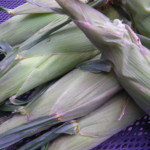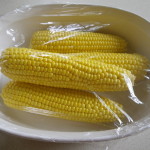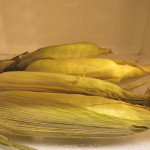 I’ve been cooking corn-on-the-cob in my microwave for many years. It’s fast and easy, especially for just one or two people. But once you start cooking more than a few ears of corn, it takes less time to boil them on the stove or cook them on the grill.
I’ve been cooking corn-on-the-cob in my microwave for many years. It’s fast and easy, especially for just one or two people. But once you start cooking more than a few ears of corn, it takes less time to boil them on the stove or cook them on the grill.
My way: I remove the husks and silk from the corn and then wash in fresh water. Place in a microwave safe dish, add ¼ cup water and cover with a tight lid or plastic wrap. Then I microwave on high about 3-5 minutes per ear. The time multiplies exponentially when you add more ears: 2 ears is 4-10 minutes and 4 ears 10-17 minutes. Let stand 5 minutes after cooking. 
A friend recently shared how to cook corn in the microwave with the husks left on. Guess where she got this recipe? You got it, on the web. I checked, there are many different websites that show this method. She simply placed the corn in the microwave, husks and silk and all and microwaved 4 minutes per ear. She then cut the stem end off and pulled the husks straight off the cob, the silks came off it slick. It appeared to work great.
Now, I hate to be a wet blanket (or maybe I should say “wet husk”) about this, but I was immediately concerned with this method for four reasons:
1) Most of the instructions on the web don’t mention washing the corn. I wash all my produce. Pesticides, dirt, mold, rotten spots and not to mention worms might be inside. If I were using this method, I’d pull back the husks and rinse well with fresh water. So, I admit, this requires removing the silk before cooking and eliminates one of the so called advantages of cooking with the silks and husks in place—easier peeling and cleaning. An alternative, when selecting corn, check for worms or worm damage in the silks.
2) Damage to the microwave. All microwave oven instruction books caution you not to use the microwave without food inside. It’s the water in the food that absorbs the microwaves and creates the heat, without water there is no cooking. This method of cooking corn does not add any water so the only moisture is that in the corn itself. With all the husks and cobs in the microwave, there are lots of dry materials inside the oven in comparison to the corn. With no place for microwaves to go, this could damage and shorten the life of or damage the magnetron in the microwave. Some instructions on the web suggested soaking the corn with husks before microwaving, t hat might help. Be sure to select moist, fresh corn because it will be cooking in its own moisture (this is good to remember for all corn!).
3) Fire in the oven. This relates back to #2 and is probably the biggest concern. The fire risk goes up with the amount of corn being placed in the oven and the added cooking time for each ear. The cobs are dry and the husks are dry and they seemed to get drier during the cooking. I noted a couple of comments by people on the web that tried this method and did have fires. If you’re going to try this, be sure to select corn that has fresh green husks, moist stem ends, check that the silk is free of decay and avoid yellowed or dried husks.
4) Burns. Use caution while husking the hot corn and watch the hot steam. My friend uses hot mitts.

I also checked with an Extension colleague and she says she doesn’t know of any research on the safety of this method. She also has a concern about fire.
I personally don’t have problems with shucking corn. I know I’m perhaps overly cautious, but I think I’ll stick to a tried-and-true method. Shucks!
Try our barbecued corn recipe.
Cheryle Jones Syracuse, MS
Professor Emeritus, The Ohio State University